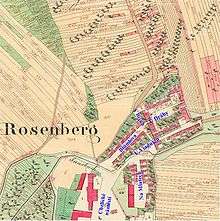Cadastral community
A cadastral community[1][2] or cadastral municipality,[3][4] is a cadastral subdivision of municipalities in the nations of Austria,[5] Bosnia and Herzegovina, Croatia,[4][6] the Czech Republic,[7] Slovakia, the Italian provinces of South Tyrol, Trentino, Gorizia, Trieste, Slovenia,[2][3] and the Netherlands. A cadastral community records property ownership in a cadastre, which is a register describing property ownership by boundary lines of the real estate.
The common etymology in the Central European successor states of the Habsburg Monarchy comes from German: Katastralgemeinde (KG), plural: Katastralgemeinden,[4][5] translated as Italian: comune censuario or comune catastale, Slovene: katastralna občina, Croatian: katastarska općina, Slovak: katastrálne územia and Czech: katastrální území ("cadastral territories").
History

In 1764, at the behest of Empress Maria Theresa of Austria, a complete survey of the Habsburg lands was begun,[8] initiated by the general staff of the Imperial and Royal Army under Field Marshal Count Leopold Joseph von Daun, who had become aware of the lack of reliable maps in the Seven Years' War. Maria Theresa's son Emperor Joseph II ordered the implication of a complete urbarium for property tax purposes in 1785. The present-day cadastre was completed after the Napoleonic Wars from 1817 onwards under Emperor Francis I of Austria (Franziszeischer Kataster). Since then, the Austrian (i.e. Cisleithanian) crown lands were subdivided in Katastralgemeinden; surveying in the Hungarian (Transleithanian) lands started in 1850. Municipalities as administrative subdivisions with certain rights of self-governance were not established until after the 1848 revolutions.
Most of the nowadays Katastralgemeinden once had been independent communes and were incorporated on the occasion of a municipal territory reforms. They can be further divided into smaller villages and localities (Ortschaften). As of 2014 there are 7,847 Katastralgemeinden in Austria. For land registration, the unit identifier used in a Katastralgemeinde is "KG-Nr" (KG-Nummer, or number).[5]
The Dutch system of kadastrale gemeenten was set up around 1830. When municipalities are merged, often the cadastral communes remain as they were, so one civil municipality can consist of more than one cadastral commune; but again, a cadastral commune can never be part of more than one civil municipality.
See also
- Districts of Vienna
- Municipalities of South Tyrol
- Municipalities of Slovenia
- Municipalities of Croatia
- Gemeinde
References
- ↑ European Commission. National Experts Group on Archives, Council of the European Union (2005). Report on archives in the enlarged European Union: increased archival cooperation in Europe : action plan. Office for Official Publications of the European Communities. p. 97. ISBN 9279008706. Retrieved 2012-06-07.
- 1 2 Statistical Yearbook of the Republic of Slovenia. Statistical Office of the Republic of Slovenia. 2008. p. 33. Retrieved 2012-06-07.
- 1 2 Slovene Academy of Sciences and Arts Geography Institute (1997). Geografski zbornik: Acta geographica. 37-39. Slovene Academy of Sciences and Arts. p. 18. Retrieved 2012-06-07.
In Slovenia, there are just under 2700 cadastral municipalities, enough for the essential characteristics of land use in Slovenia to be reflected in the ratios between land categories.
- 1 2 3 Adam Jolly, ed. (2006). Professional Property Briefing: Croatia. GMB Publishing Ltd. p. 38. ISBN 1846730015. Retrieved 2012-06-07.
- 1 2 3 Cadastral Template for Austria, web-page: CT-AT
- ↑ Boc, Krunoslav (March 2009). "Creating Digital Cadastre Maps and their Comparison with the Written Part of the Land Operator". Geodetski list (in Croatian). Zagreb, Croatia: Croatian Geodetic Society. 63 (86) (1): 39–53. ISSN 0016-710X. Retrieved 2012-06-07.
ukupno 3364 [katastarskih općina], koliko ih ima u Republici Hrvatskoj
- ↑ Cadastral Template for Czech Republic), web-page: CT-CZ
- ↑ Votruba, Martin. "Maria Theresa's Urbarium". Slovak Studies Program. University of Pittsburgh.
External links
- Cadastral Template -- A Worldwide Comparison of Cadastral Systems
- CT-C4 - Description of what kind of registers are operated and maintained in different countries